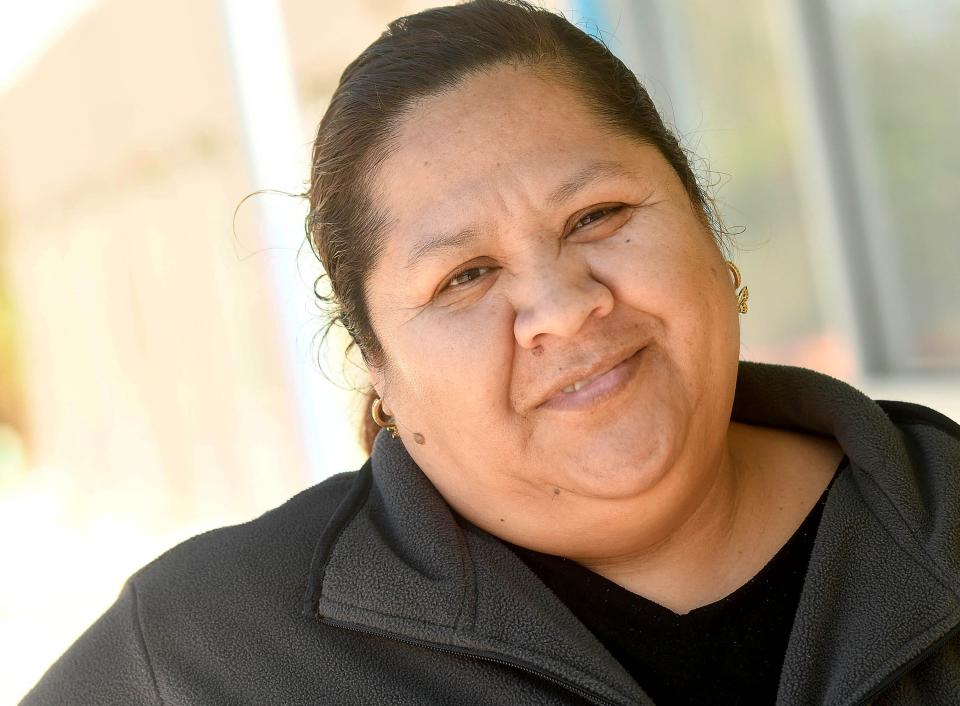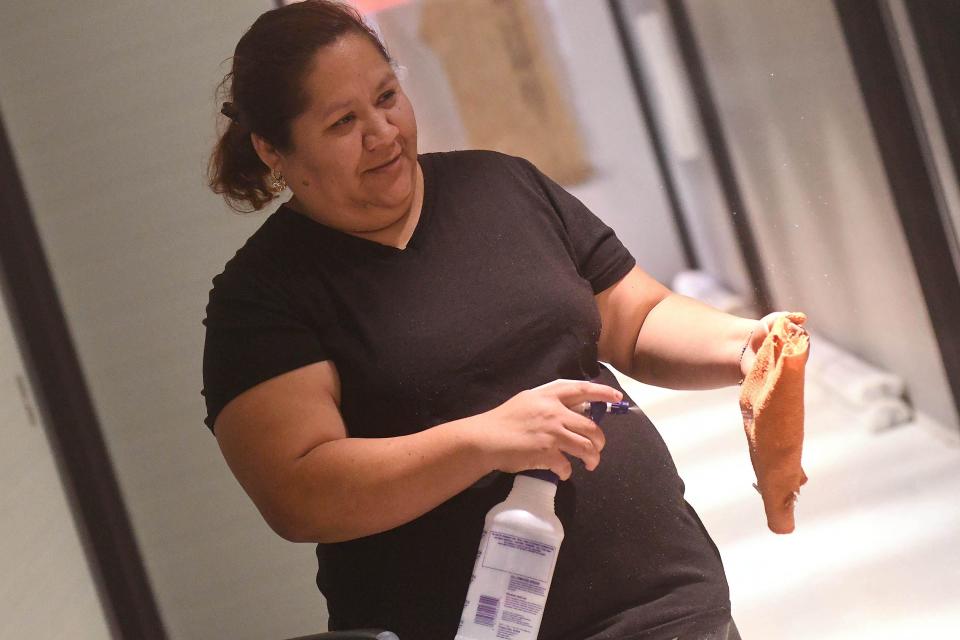This group of young women is seeing a staggering rise in uterine cancer. Experts don't know why.
For six years, Martha Dejulian Ronquillo suffered severe anemia and depression. The mother of two in her late 30s often called out of work as a housekeeper because of fatigue and pain.
During those years, Ronquillo bled daily and heavily outside of her periods. The blood loss led to chronic depression and so much iron deficiency that she needed three iron transfusions.
Clinicians prescribed medicines to stem the bleeding, but they didn’t work.
“It was a very terrible time,” said Ronquillo, who lives in Wilmington, North Carolina. “I didn't want to exist anymore. I just wanted to die.”
Finally, in the summer of 2019, doctors referred her to a specialist who took a biopsy. Her uterus had precancerous cells that probably would progress into cancer, the doctor told her.
Two months after turning 39, Ronquillo had a hysterectomy.
“I feel very grateful,” said Ronquillo, now 42, through a translator. “I feel more comfortable.”
She isn’t alone.
Uterine cancer is generally more common in older women and is long known to disproportionately strike Black women. Now, new research adds to growing evidence that uterine cancer also is rising rapidly among reproductive-aged Hispanic women, adding to the alarming pattern of the disparity among women of color.

In 2018, Hispanic women had the highest uterine cancer rate among young reproductive-age women ages 35 to 39 – a rate 50% higher than that of white women, according to the study of more than 840,000 uterine cancer patients published in the journal Gynecologic Oncology.
Cases have been rising a steady 4% each year since 2001.
“It is staggering,” said Yale School of Medicine Dr. Sangini Sheth, an obstetrician and gynecologist who was not involved in the study.
Over the next five years, Hispanic women in the western U.S. ages 35 to 39 could see a uterine cancer rate triple that of white women, said study co-author Dr. Cortney Eakin, an obstetrician-gynecologist and research fellow at the University of California, Los Angeles.
Experts are trying to figure out what is causing the disparity and raise awareness among medical professionals and patients to get screened.
“These are young women. That bothers me,” said Sutter Health obstetrician and gynecologist Dr. John Chan, co-author on the study with Eakin. “Something is going on with the young Hispanic women. We need to do something to protect them.”
Cutting-edge advances in cancer are underway: 3 that could change lives.
Inequities in maternal health care are not new: They have deep roots in history
'They cannot just brush it off': What's behind the disparity?
Obesity raises risk of uterine cancer, as does diabetes. Both of those disorders are found disproportionately in Hispanic people. In the U.S., the CDC estimates Hispanic adults are 1.2 times as likely as white people to live with obesity.
One option to lower the risk for uterine cancer is taking a contraceptive, said Ronquillo’s gynecologic oncologist, Dr. Lucybeth Nieves-Arriba, of Novant Health in North Carolina.
But that might not be an option if a patient has obesity or smokes because of complications like blood clots, she said. That’s why it’s essential, she said, to work with a clinical team for a personalized plan to catch it early and evaluate options.
“With awareness, in any doctor these little flashlights should turn on: If they see somebody that is obese and having irregular periods, they cannot just brush it off,” she said.
But experts such as Nieves-Arriba and Eakin also know obesity is probably not the only factor.
“Are these disparities driven by obesity alone? Probably not. Obesity is, however, at least one modifiable risk factor that we should address,” Eakin said.
Addressing social determinants of health within communities of color can help, such as helping women with lifestyle improvements and diet, as well as providing access to evaluations to catch precancerous lesions early, Chan said.
But he echoed that obesity may be an oversimplified explanation for the problem and said more studies need to explore reasons for the disparity.
“It's a group of patients with unmet needs,” he said. "We really don't know why we (only) blame it on obesity – we really don't understand it completely.”
Uterine cancers that develop in reproductive-age women are typically lower-risk types, meaning there's less risk of spread – but getting evaluated early is key, experts say.
Related: Obesity was long considered a personal failing. Science shows it's not.
What to know: A 'quiet' liver disease is on the rise in kids and Hispanic people
Why uterine cancer in younger women is often missed
Experts are most concerned about the most pronounced surge being among those younger premenopausal Hispanic women, and awareness of symptoms often is lacking among that age bracket across racial groups. Those symptoms are typically abnormal bleeding, pelvic pain and pressure.
“In younger women, sometimes it's really difficult to catch bleeding abnormalities, particularly if you've already always had kind of irregular periods,” Eakin said.
Coupled with clinicians associating uterine cancer with older, postmenopausal patients, the disease can go under the radar in younger women.
Getting timely evaluations can help early detection before cancer spreads. It’s particularly important for younger women who plan to have children because it can influence treatment plans.
Hormones, for example, can be a possible treatment, Eakin said.
"It doesn't necessarily mean that you have to have a hysterectomy,” she said. “It becomes really important when you're talking about a woman who's diagnosed with uterine cancer at 30, or 35, and isn't sure whether or not she wants more kids.”
Still, the patient may need a hysterectomy. Most hysterectomies are done at ages 40 to 50.
In Ronquillo's case, doctors prescribed three medications over the six years because she had hoped to have more children.
But the bleeding persisted, which led to the hysterectomy.
“It's important to raise awareness so that people get evaluated early, so we can catch it at a time that options other than surgery may still be feasible,” Eakin said.
But along with lack of access to health care, which people of color suffer disproportionately, stigma can get in the way of getting screened.
Paula Saldana, field coordinator at the Latina Institute for Reproductive Justice, said many women in her Houston community are hesitant to get preventative care to detect such disorders at an earlier stage. Historically, American women of color suffered medical abuses that contribute to skepticism. Hispanic, Native American and Black women, for example, endured disproportionate, coerced hysterectomies.
When they go to a clinic, there can be barriers from stigma, Saldana said, “where they were embarrassed. Or I would even hear stories about their partners not letting them access the care that they needed because it had to do with reproductive care.”
Like Saldana, "promotoras," or community health workers, play a key role in referring patients to care, along with mobile units that go into the community for screenings.
Ronquillo said she was grateful Nieves-Arriba “was able to detect this on time" and hopes other clinicians will "keep diagnosing – and diagnosing on time."
She wants other women like her to "listen when they have heavy bleeding – don't ignore it," she said. "Sometimes, we do not have self-love."

Reach Nada Hassanein at nhassanein@usatoday.com or on Twitter @nhassanein_.
This article originally appeared on USA TODAY: Uterine cancer rapidly rising in young, Hispanic women in the US

